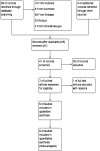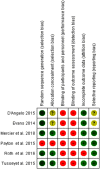Use of the peanut ball during labour: A systematic review and meta-analysis
- PMID: 33773071
- PMCID: PMC8363404
- DOI: 10.1002/nop2.844
Use of the peanut ball during labour: A systematic review and meta-analysis
Abstract
Aim: This study aimed to determine effectiveness of peanut ball on the duration of the stages of labour and frequency of caesarean section.
Design: A systematic review and meta-analysis.
Method: A comprehensive electronic search was carried out with no time limit until December 2020. Collected data were analysed using software RevMan- version 5.3. Heterogeneity was assessed using I2 , T2 , and 2 . GRADE approach was used to assess the certainty of evidence.
Results: The meta-analysis on six clinical trials with 645 participants showed no statistically significant difference between the two groups in caesarean surgery rate (RR = 0.82) and length of the first (MD = -15.64).
Conclusions: Therefore, further clinical trials with stronger evidence should be carried out to assess the effectiveness of peanut ball on caesarean surgery rate and length of first and second stages of labour.
Keywords: caesarean section; labour; labour ball; peanut ball; systematic review.
© 2021 The Authors. Nursing Open published by John Wiley & Sons Ltd.
Conflict of interest statement
The authors declare no conflict of interest.
Figures





Similar articles
-
Epidural versus non-epidural or no analgesia for pain management in labour.Cochrane Database Syst Rev. 2018 May 21;5(5):CD000331. doi: 10.1002/14651858.CD000331.pub4. Cochrane Database Syst Rev. 2018. PMID: 29781504 Free PMC article.
-
Relaxation techniques for pain management in labour.Cochrane Database Syst Rev. 2018 Mar 28;3(3):CD009514. doi: 10.1002/14651858.CD009514.pub2. Cochrane Database Syst Rev. 2018. PMID: 29589650 Free PMC article.
-
Discontinuation of intravenous oxytocin in the active phase of induced labour.Cochrane Database Syst Rev. 2018 Aug 20;8(8):CD012274. doi: 10.1002/14651858.CD012274.pub2. Cochrane Database Syst Rev. 2018. PMID: 30125998 Free PMC article.
-
Immersion in water during labour and birth.Cochrane Database Syst Rev. 2018 May 16;5(5):CD000111. doi: 10.1002/14651858.CD000111.pub4. Cochrane Database Syst Rev. 2018. PMID: 29768662 Free PMC article.
-
Acute tocolysis for uterine tachysystole or suspected fetal distress.Cochrane Database Syst Rev. 2018 Jul 4;7(7):CD009770. doi: 10.1002/14651858.CD009770.pub2. Cochrane Database Syst Rev. 2018. PMID: 29971813 Free PMC article.
Cited by
-
Investigation of the effects of peanut ball during labor: An updated systematic review and meta-analysis.Eur J Midwifery. 2025 Mar 14;9. doi: 10.18332/ejm/201345. eCollection 2025. Eur J Midwifery. 2025. PMID: 40093334 Free PMC article.
-
Effects of peanut ball use on perceived labor pain, fatigue, and mother's perception of childbirth: a randomized controlled trial.Arch Gynecol Obstet. 2025 Jun;311(6):1579-1589. doi: 10.1007/s00404-024-07656-2. Epub 2024 Aug 5. Arch Gynecol Obstet. 2025. PMID: 39103620 Free PMC article. Clinical Trial.
References
-
- Caughey, A. B., Cahill, A. G., Guise, J. M., & Rouse, D. J. (2014). American College of Obstetricians and Gynecologists. Safe prevention of the primary cesarean delivery. American Journal of Obstetrics and Gynecology, 210(3), 179–193. - PubMed
-
- Chao, A. S., Chao, A., Wang, T. H., Chang, Y. C., Peng, H. H., Chang, S. D., Chao, A., Chang, C. J., Lai, C. H., & Wong, A. M. (2007). Pain relief by applying transcutaneous electrical nerve stimulation. (TENS). On acupuncture points during the first stage of labor: A randomized double‐blind placebo‐controlled trial. Pain, 127, 214–220. 10.1016/j.pain.2006.08.016 - DOI - PubMed
-
- Cheng, Y. W., Delaney, S. S., Hopkins, L. M., & Caughey, A. B. (2009). The association between the length of first stage of labor, mode of delivery, and perinatal outcomes in women undergoing induction of labor. American Journal of Obstetrics & Gynecology, 201, 477. e1–477. e7. 10.1016/j.ajog.2009.05.024 - DOI - PubMed
Publication types
MeSH terms
LinkOut - more resources
Full Text Sources
Other Literature Sources
Medical

